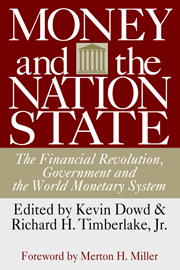Really big currency crises that affect many countries at once used to happen about once a decade. Already in the 1990s, though, we’ve had three. The first was in 1992, when Western European countries failed to uphold their pegged exchange rates with the German mark. Currency speculator George Soros earned more than $1 billion in a single day by betting correctly that Britain would devalue the pound. The second big crisis was in 1994, when Mexico devalued the peso, sending its economy into a year-long depression and frightening investors in other emerging markets. The third big crisis is the East Asian crisis, which began last July and is still causing problems from the mountains of South Korea to the jungles of Indonesia.
Currency crises have become more and more frequent in part because speculators can mobilize more and more money. A generation ago, central banks, like the U.S. Federal Reserve System, had more money than anyone else and weren’t afraid to use it to punish speculators. Today, big currency speculators like Mr. Soros can borrow more money than central banks have. But foreign-exchange speculators don’t make currencies devalue; they just create pressure. It is up to governments to fight the pressure or give into it. For decades central banks have assumed the responsibility for managing currencies but, as the big crashes of the 1990s show, it is a task they are poorly equipped for nowadays.
Given the longevity of central banks, most of us take their necessity for granted—few remember life before the Federal Reserve was created in 1914. But central banking is not the only possible monetary system, nor is it the most conducive to exchange-rate stability and economic growth. After the Mexican peso collapsed in 1992, Argentina suffered a recession but did not devalue. In the East Asian currency crisis, Hong Kong alone has withstood the speculative pressure to devalue. What explains the relative stability of the Argentine peso and the Hong Kong dollar? Both are managed not by central banks but by currency boards.
A currency board is designed to promote currency stability. It upholds a fixed exchange rate with a foreign “anchor” currency, such as the U.S. dollar in the case of Hong Kong and Argentina, and holds 100 percent foreign reserves. Thus its monetary base (paper money, coins, and deposits at the currency board) is fully backed. Unlike a typical central bank, which holds much less than 100 percent foreign reserves, a currency board always has enough reserves to pay off everyone who wants to exchange its paper money for the anchor currency. Not surprisingly, currency boards (which have existed in almost 80 countries) have an excellent record: no devaluations, fewer currency crises than central banks, lower inflation, and higher average economic growth than central banking systems.
Another alternative system worth considering—one enjoying a revival of interest among economists dissatisfied with central banking—is free banking. Under free banking, banks issue money competitively, with no central bank or other government involvement. Different brands of paper money may circulate side-by-side in the marketplace, just as different brands of travelers checks or credit cards do today. Although it may sound potentially chaotic, free banking (practiced at some time by almost 60 countries but by none today) generally worked much better than central banking. Currency crises were fewer and inflation was lower. Free banks rarely overissued bank notes because to do so would have weakened their reputations, making their notes circulate at a discount to face value and risking runs by leery depositors.
Central banking replaced free banking and currency boards for political reasons, not economic ones. (In the United States, free banks fell victim to legal requirements to hold lots of government bonds or to pay prohibitively high excise taxes on the face value of the notes they issued.) Governments understood that central banks would give them greater power over money, enabling them to extract a kind of tax through inflation. As former Federal Reserve chairman Paul Volcker has written, “It is a sobering fact that the prominence of central banks in this century has coincided with a general tendency towards more inflation, not less.” One-third or more of all countries with central banking have experienced inflation rates of at least 100 percent a year, compared to no countries with currency boards or free banking.
Now that the East Asian economies (except Hong Kong) have devalued, their inflation rates are headed from single digits to 20 or 30 percent. They will go through a version of what the United States experienced in the late 1970s and early 1980s: a recessionary wringer to correct the mistake of the inflation. The shame is that they could have avoided much of their pain. The policies of their central banks turned what should have been a pothole along the road of economic growth into a gaping ditch.
Big currency crises will continue as long as central banking remains widespread. Just a few years ago, people would have concluded that there was no solution. Today it is becoming ever clearer that countries where central banks perform badly need not remain stuck in the ditch. Currency boards and free banking provide ways out.







